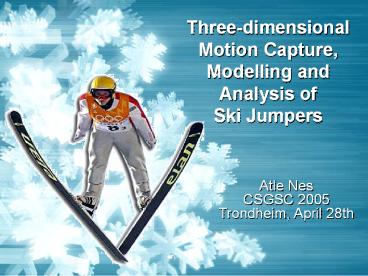Three-dimensional Motion Capture, Modelling and Analysis of Ski Jumpers - PowerPoint PPT Presentation
Title:
Three-dimensional Motion Capture, Modelling and Analysis of Ski Jumpers
Description:
Three-dimensional Motion Capture, Modelling and Analysis of Ski Jumpers Atle Nes CSGSC 2005 Trondheim, April 28th Overview Project description What kind of data are ... – PowerPoint PPT presentation
Number of Views:376
Avg rating:3.0/5.0
Title: Three-dimensional Motion Capture, Modelling and Analysis of Ski Jumpers
1
Three-dimensional Motion Capture, Modelling and
Analysis of Ski Jumpers
- Atle NesCSGSC 2005 Trondheim, April 28th
2
Overview
- Project description
- What kind of data are we interested in?
- Capturing data Image acquisition, Camera
system - Processing data Feature points, Motion capture,
Photogrammetry - Interpreting data Visualization, Motion
analysis - Conclusion
3
Project description
- Task Design a computer system that can capture
and study the motion of ski jumpers in 3D. - Goal The results will be used to give feedback
to the ski jumpers that can help them to increase
their jumping lengths.
4
Data collection
- Will be gathered and analyzed in close
cooperation with Human Movement Science Program
at NTNU. - Data
- Mainly from outdoor ski jumps captured at
Granåsen ski jumping hill here in Trondheim. - Also from indoor ski jumps captured at Dragvoll
sports facilities.
5
Granåsen ski jump arena
6
Image acquisition
- Video sequences are captured simultanuously from
multiple video cameras. - Two decisive camera factors
- Spatial resolution (pixels)
- Time resolution (frame rate)
7
Camera equipment
- 3 x AVT Marlin F080b
- IEEE1394 Firewire, DCAM
- 8-bit greyscale w/ max resolution 1024x768x15fps
or 640x480x30fps - Extra trigger cable/signal ? Video capture
synchronization. - Different camera lenses ? Capture the same area
from different distances. - Optical fibre ? Extends the distance from
computer to cameras in the hill, keeping the
transmission speed.
8
Feature points
- Robust feature points
- Human body markers (easy detectable)
- Naturally robust features (more difficult).
- Want to have automatic detection of robust
feature points using simple image processing
techniques.
9
Motion capture
- Localizing, identifying and tracking identical
feature points in both sequences of video images
as well as accross different camera views. - Synchronized video streams ensures good 3D
coordinate accuracy.
10
Tracking w/ missing data
?
- Occluded features ? Redundancy using multiple
cameras with different views. - Probability theory ? Guess the point position
based on feature point velocity. - Another problem ? Blur effect
11
Photogrammetry
- Matching corresponding feature points from two or
more cameras allows us to calculate the exact
position of that feature point in 3D. - Good camera placement is important for good
triangulation capabilities (3D coordinate
accuracy).
12
Camera calibration
- Coordinate system ? On site calibration using
known coordinates in the ski jumping arena. - Direct Linear Transformation (DLT) by Abdel-Aziz
and Karara in 1971. - Lens distortion (unlinear)
- Intelligent removal of the worst calibration
points (sources of error).
13
Visualization
- Feature point tracks are connected back onto a
dynamic model of the ski jumper. - Dynamic model of ski jumper is combined with
static model of ski jump arena.
14
Motion analysis
- Done in close cooperation with Human Movement
Science Program - Extract movements that have greatest influence on
the result. - Using statistical tools and prior knowledge about
movements - Project some movements to unseen 2D views.
15
Related applications
- Medical
- Diagnosis of infant spontaneous movements for
early detection of possible brain damage
(cerebral palsy). - Diagnosis of adult movements (walk), for
determination of cause of problems.
16
Related applications 2
- Sports
- Study top athletes for finding optimal movement
patterns. - Surveillance
- Crowd surveillance and identification of possible
strange behaviour in a shopping mall or airport.
17
Conclusion
- I have presented an overview of a system that can
capture, visualize and analyze ski jumpers in a
ski jumping hill. - Remains to see how well such a system can perform
and if it can help the ski jumpers improve their
skills.
18
Any questions?































